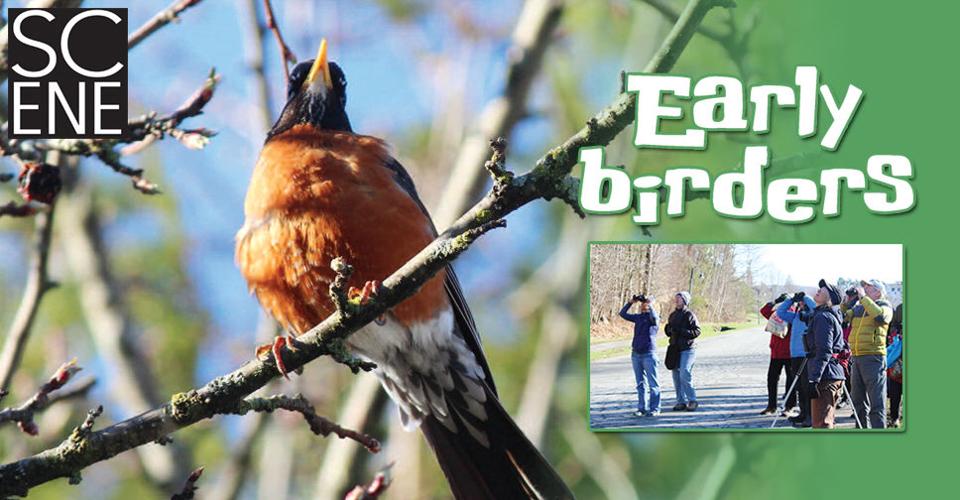Shhhh. Listen. What sounds like Morse code is being tapped out on a hollow tree across the wetlands. It crosses my mind that nature could be sending me a message, but what is it? Tap. Tap-tap-tap. Tap.
A line of binoculars turns toward the sound.
Tap. Tap-tap-tap. Tap. The message sounds again.
Gazing out into the rising sun, a halo is cast on the tops of the trees, making it difficult to pick out the messenger.
“Sometimes, if you hear a bird, and can’t find it, you can move up the road a little way and listen, you can triangulate,” advised Tom Kastner.
The tapping bird can’t be seen, but Liz Lackey, a Stowe resident and one of the guides for Stowe Area Birders, names the species from its pattern of drumming.
“Yellow-bellied sapsucker,” she says. “They are the only woodpecker with a syncopated beat. It’s as if he has a stutter, or maybe he’s into jazz.”
Yellow-bellied sapsuckers are enterprising woodpeckers. They lap up trees’ leaking sap and any trapped insects with their specialized, brush-tipped tongues.
Attired sharply in black and white, with a red cap — and a red throat in males — they sit still on tree trunks for long intervals while feeding.
As the woodpecker taps out his jazzy beat, pine warblers and chickadees join in the song, before a familiar robin adds her cheery tune to the chorus.
Spring mornings in Stowe are like a symphony of birdcalls, conducted by the rising sun and increasing temperatures.
As morning dawns, and the glistening dew begins to fade, the birds come out to sing, feed and play.
Every Sunday from now until June 11, Stowe Area Birders, a group of local avian enthusiasts, meets in the parking lot of Helen Day Art Center at 6:45 in the morning for a two-hour bird-watching tour through areas of Stowe.
The season began on April 23 with a walk around the neighborhood, past the wetlands on Depot Street and on toward Copley Woodlands. Each week, the group picks a new spot to tour, and will carpool to the site if needed.
The group is led by husband-and-wife team Charlotte and Tom Kastner, along with lifelong Stowe resident Liz Lackey, who used to bird-watch in the area with her parents when she was young.
And while they say you hear 10 times more than you see on these walks, these skilled guides can identify almost every call.
Stowe birds
“I know a lot of birdcalls, I bird everyday,” said Lackey, who has been watching the migrants return for the past few months. “It has been raining a lot, and many birds don’t like to migrate in the rain,” but many have still returned, and a few species actually came back earlier than usual.
Over the last 30 years, Lackey has also been seeing an increase of bird species for which Vermont used to be too cold now breeding in the Stowe area. Cardinals, for example, used to be a more southern bird, but are now prevalent in the northeast, as are Carolina wrens.
“The dates they are returning are much earlier too,” Lackey said. “I saw the first bluebird on Feb. 28.”
“We’ve had grackles and Starlings since February as well,” Charlotte Kastner said.
Lackey and other birders worldwide track their bird sightings on ebird.org — an extension of the Cornell Lab of Ornithology in Lansing, N.Y. — so that scientists can use the data to document the presence or absence of species, as well as their abundance in a region.
Through her own observations, Lackey, who studied natural science and ornithology at Cornell, has noticed a decline in insect-eaters, particularly barn swallows and tree swallows.
Her observations match a 25-year study completed by Vermont Center for Ecostudies that shows from 1988 to 2013, aerial insectivores — birds that eat mostly flying insects, while flying — have declined by about 45 percent in the state.
“It’s scary to me,” Lackey said. “And I think that we have so much to learn.”
Stowe Area Birders isn’t all about the doom-and-gloom of bird decline. Many birders just like to get out in nature, and in their community.
The Kastners started Stowe Area Birders back in 2002, and welcome anyone in the region to join in.
The Kastners used to live on Nantucket, where they’d go birding with a local group. When they moved to Stowe in 2001, the couple thought it would be cool to start a similar group here.
They started in 2002, and figured they’d “see what happens.”
It has been going strong ever since, and when the Kastners left Stowe for about three years, Lackey took over until their return.
For the Kastners, birding is another way to interact with the community.
“For me, I like that we go to different places in Stowe,” said Charlotte Kastner. “It’s a different way to learn about the place we live. Birding gets you out into different areas that you may not go to on a regular basis.”
“It’s interesting how long I’ve lived here, and didn’t know about some of the areas in town,” said Julie Nitschke of Stowe.
Along the tour, the group of about a dozen birders picked out mourning doves, juncos, chipping sparrows, crows, red-wing blackbirds, swamp sparrows, ruby-crowned kinglets, turkey vultures and many other species.
After the walk, everyone’s invited to join the Kastners for a cup of coffee.


























(0) comments
Welcome to the discussion.
Log In
Keep it clean. Please avoid obscene, vulgar, lewd, racist or sexual language.
PLEASE TURN OFF YOUR CAPS LOCK.
Don't threaten. Threats of harming another person will not be tolerated.
Be truthful. Don't knowingly lie about anyone or anything.
Be nice. No racism, sexism or any sort of -ism that is degrading to another person.
Be proactive. Use the "Report" link on each comment to let us know of abusive posts.
Share with us. We'd love to hear eyewitness accounts, the history behind an article.